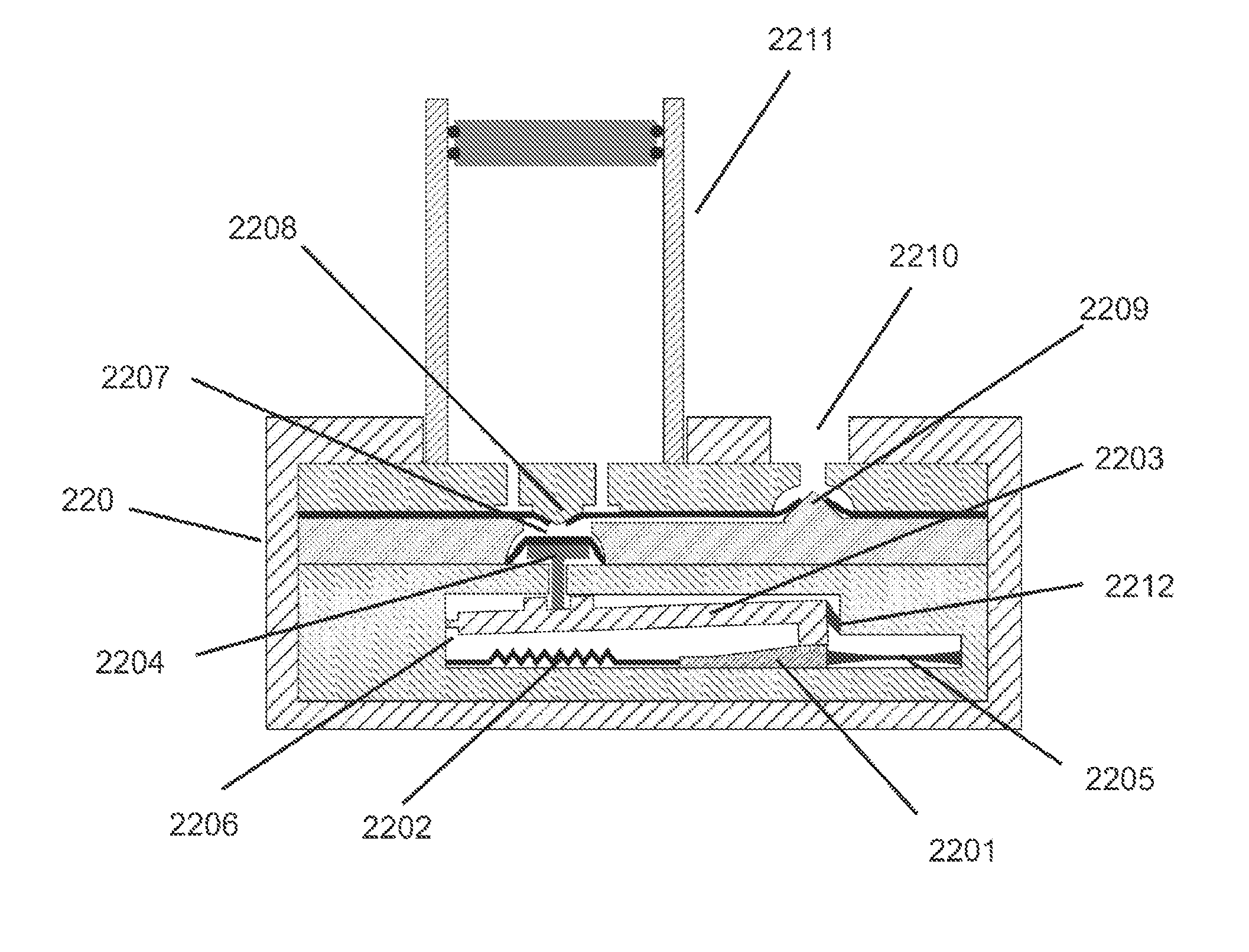Mechanical driver
a mechanical driver and driver technology, applied in the field of mechanical drivers, can solve the problems limiting the design opportunities, and limiting the complexity of the design, etc., and achieve the effect of reducing the volume of the pumping chamber
- Summary
- Abstract
- Description
- Claims
- Application Information
AI Technical Summary
Benefits of technology
Problems solved by technology
Method used
Image
Examples
first embodiment
[0052]the mechanical driver is shown in FIG. 1. The mechanical driver is a miniature mechanical driver. FIG. 1 shows the miniaturised mechanical driver 10 in its non activated state. The miniaturised mechanical driver 10 comprises a wedge shaped member 102. The wedge shaped member 102 is arranged so that it can move in one plane and in an essentially linear direction. The wedge shaped member 102 has at least one angled surface arranged so that it forms an angle with the direction of travel of the wedge shaped member 102. A shape memory actuator 103 is fixed to the wedge shaped member 102 at one end and to the frame 105 of the miniaturised mechanical driver 10. The shape memory actuator 103 is arranged so that it acts along the linear direction of travel of the wedge shaped member 102. The shape memory actuator 103 is also referred to as shape memory alloy. Both terms relate to an actuator made from a shape memory alloy material. A return spring 104 is attached at one end to the wedg...
second embodiment
[0058]FIG. 5 shows the activated form of the mechanical driver according to the present invention. The shape memory alloy 503 is heated preferably by passing an electric current through it. The heated shape memory alloy 503 contracts and moves the wedge shaped member 502 from its first position shown in FIG. 4 to its second position shown in FIG. 5. When the wedge shaped member 502 moves from its first position to its second position it elongates the return spring 505. When the wedges shaped member 502 moves from its first position to its second position it also moves the lever 504 from its first position shown in FIG. 4 to its second position shown in FIG. 5. The lever moves in an angular direction about the pivot point 507. When the lever 504 moves to its second position it moves the piston 501 from its first position shown in FIG. 4 to its second position shown in FIG. 5. In the mechanical driver 50, the lever 504 is connected to the frame at the fixed rotation point 507. The pis...
fourth embodiment
[0063]When the wedge shaped member 902 moves from its first position to its second position it moves the lever 904 from its first position shown in FIG. 8 to its second position shown in FIG. 9. When the lever 904 moves to its second position it moves the piston 901 from its first position shown in FIG. 8 to its second position shown in FIG. 9. FIG. 9 furthermore shows the piston 901 and the piston drive point 906 of the lever 904 of the mechanical driver 90. the mechanical driver according to the present invention has the advantage of increasing the distance the wedge shaped member is able to displace the lever and the piston for a given length of contraction by the shaped memory alloy without an increase in the angle of the angled surface.
[0064]It will be appreciated by those skilled in the art that the wedge shaped member and the frame described in the fourth embodiment of the mechanical driver according to the present invention can be incorporated into the first and second embod...
PUM
 Login to View More
Login to View More Abstract
Description
Claims
Application Information
 Login to View More
Login to View More - R&D
- Intellectual Property
- Life Sciences
- Materials
- Tech Scout
- Unparalleled Data Quality
- Higher Quality Content
- 60% Fewer Hallucinations
Browse by: Latest US Patents, China's latest patents, Technical Efficacy Thesaurus, Application Domain, Technology Topic, Popular Technical Reports.
© 2025 PatSnap. All rights reserved.Legal|Privacy policy|Modern Slavery Act Transparency Statement|Sitemap|About US| Contact US: help@patsnap.com



